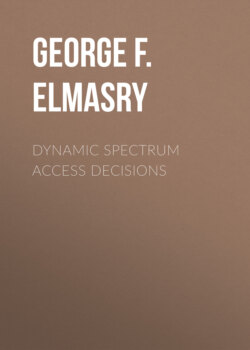Читать книгу Dynamic Spectrum Access Decisions - George F. Elmasry - Страница 48
Notes
Оглавление1 1 Please reference Appendix 2A for an explanation of the use of the term “energy detection” in spectrum sensing.
2 2 Notice that dB is a logarithmic scale that is used to describe the ratio of signal to noise.
3 3 WiFi is a trademarked phrase that means IEEE 802.11.
4 4 Opportunistic use of a spectrum by a secondary user is one example of opportunistic spectrum use. The more common opportunistic spectrum use is with unlicensed frequency bands where any user looks for spectrum holes to transmit on.
5 5 This one unit of energy can be dependent on the sensing time period.
6 6 The reader can refer to digital communications specialized references on how a signal is constructed in multidimensional SiS.
7 7 With same‐channel in‐band sensing, T is well correlated to the dwell time, as explained in Chapter 3.
8 8 M is typically a power of 2. With a binary antipodal signal, M = 2. With a 4‐ary phase shift keying signal, M = 4. With 8‐ary phase shift keying, M = 8. QAM signals can be 16, 32, 64, etc. Except for the binary antipodal signal, which has one direction, all of these examples have a two‐dimensional signal (i.e., N = 2). Orthogonal signals can have higher dimensions.
9 9 Statistical decisions in symbol detection also have a probability of false alarm and a probability of misdetection. However, both probabilities result in detecting the wrong symbol and hence most signal detection techniques are interested in the probability of symbol error without the distinction between the probability of false alarm and the probability of misdetection.
10 10 The differences between S(t) and S*(t) are two‐fold. The first difference is the added noise in S*(t). The second difference, which can have a larger impact, is the time lag between the samples of S*(t) and S(t). If the time lag is zero, S*(t) is aligned to S(t) and this process becomes a convolution process.
11 11 Signal detection using autocorrelation can also happen in frequency domain where noise covariance can be better estimated.
12 12 OFDM is used in both commercial and defense signals. Commercial signals include WiMAX, LTE 5 MHz, LTE 20 MHz, and 5G. Defense signals include the wideband networking waveform (WNW) and the soldier radio waveform (SRW).
13 13 This opportunistic use can be by another commercial signal or a military signal.
14 14 All the jammer needs to do is to jam enough frequency slots to cause error patterns that make the military signal error correction coding fail to correct the error patterns. This type of spectrum sensing is a cat and mouse game. The defense signal platform spectrum sensing can monitor if the jammer succeeds in overcoming the defense signal before switching the signal to a different mode or using another signal type.
15 15 Spread spectrum based sensing was covered earlier in this chapter.
16 16 The preambles mentioned here are different from the time domain preamble, which is a sequence of symbols in the transmitted frame. The preambles here are frequency domain preambles.
17 17 In defense applications, this area of operation is referred to as the theater of operation.
18 18 Wavelet transform is widely used in digital image processing. With spectrum sensing, it can be used with sensing signals that use a wideband.
19 19 An even signal is symmetric around the vertical axes. An odd signal is symmetric about the origin.
